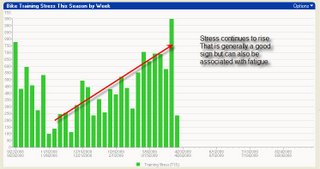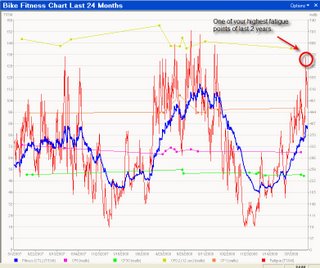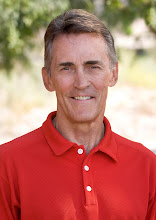Fatigue Indicators
I’ve been a bit concerned about one of the cyclists I coach. He’s in his late 50s and is very focused on his training and racing this season. He's a strong rider. Last week on his Tuesday evening, group ride he was dropped twice. That’s very unusual for him.
He and I could see things weren’t right, and so we cut back on training fairly dramatically for the last three days before his race last weekend. I hoped that would do it. It didn’t. That Saturday, in his first road race of the season, a B-priority, he couldn’t hold the wheel of his chase partner on a climb. So he dropped back to the second group where he finished. It wasn’t a very good start to his season.
Here are some of the things we should have caught earlier and made adjustments. All of these charts come from my WKO+ software, which I rely on a lot in coaching. This chart shows the increase in his weekly, cumulative Training Stress Score over the course of this season so far. You can see weeks where we cut back on training to allow for rest. But the big mistake appears to have been in March. There you can see four weeks of fairly high stress sandwiched by two rest and recovery weeks. In retrospect we tried to cram in too much training load to take advantage of some warm days (he lives in a very cold and snow-packed location). That was a mistake. The high TSS week on the right is his race week and most of that spike comes from the race.
This chart shows the increase in his weekly, cumulative Training Stress Score over the course of this season so far. You can see weeks where we cut back on training to allow for rest. But the big mistake appears to have been in March. There you can see four weeks of fairly high stress sandwiched by two rest and recovery weeks. In retrospect we tried to cram in too much training load to take advantage of some warm days (he lives in a very cold and snow-packed location). That was a mistake. The high TSS week on the right is his race week and most of that spike comes from the race. This chart shows his power distribution by zones for the last 28 days leading up to this race (on the right) and the same 28-day period from last year (on left). In the right-hand chart notice the spike in zone 3 (“TE”) power relative to 2007’s zone 3. It’s hard to tell without knowing the numbers but what happened here was that his zones 4 (“TH”), 5 (“VM”) and 6 (“AC”) power are lower this year at this time. Essentially, it appears he has been spending a lot of time in zone 3 and less in zones 4, 5, and 6. I expect we’d find that someone who is tired would do that. Working at what feels like a hard effort would produce zone 3 power a lot of the time. His training and workouts during this 28-day period were essentially the same as during last year’s.
This chart shows his power distribution by zones for the last 28 days leading up to this race (on the right) and the same 28-day period from last year (on left). In the right-hand chart notice the spike in zone 3 (“TE”) power relative to 2007’s zone 3. It’s hard to tell without knowing the numbers but what happened here was that his zones 4 (“TH”), 5 (“VM”) and 6 (“AC”) power are lower this year at this time. Essentially, it appears he has been spending a lot of time in zone 3 and less in zones 4, 5, and 6. I expect we’d find that someone who is tired would do that. Working at what feels like a hard effort would produce zone 3 power a lot of the time. His training and workouts during this 28-day period were essentially the same as during last year’s. Here you can see his Performance Management Chart for the last 24 months. This is perhaps the most telling of all. The blue line represents his fitness (“Chronic Training Load”) while the red line represents fatigue (“Acute Training Load”). The right side of the chart takes him up to the race described above. Notice how his fatigue has been climbing fairly steadily since November. It closely matches what we see in his TSS chart above. The week of the race he was experiencing his highest fatigue of the year, and one of his highest fatigue levels in the last two years. Before this same race last year his fitness was about 22% lower by this same weekend, as was his fatigue.
Here you can see his Performance Management Chart for the last 24 months. This is perhaps the most telling of all. The blue line represents his fitness (“Chronic Training Load”) while the red line represents fatigue (“Acute Training Load”). The right side of the chart takes him up to the race described above. Notice how his fatigue has been climbing fairly steadily since November. It closely matches what we see in his TSS chart above. The week of the race he was experiencing his highest fatigue of the year, and one of his highest fatigue levels in the last two years. Before this same race last year his fitness was about 22% lower by this same weekend, as was his fatigue.
The bottom line is we made a mistake in his training when we decided to take advantage of the warm weather back in March. And this was exacerbated by a lot going on in his off-the-bike life. There was simply too much stress load without allowance for it to subside. As his coach, this is my fault. It goes against everything I preach about the periodic need for rest and recovery. There’s a lot more to the story, but it’s sufficient to say here that this won’t happen again. He is now resting some more to be ready for this weekend’s race. If this doesn’t do it then he’s in for even more rest next week. It simply doesn’t pay to take shortcuts.


19 Comments:
As a 58 year old triathlete training about 7-8 hours a week for sprint tris I seem to bump up against the fitness/fatigue equation in a very similar manner. I can handle the training it seems for several months then out of no where eventually there is a crash.
I'm on a 2 week on 1 week rest cycle. I just seemed to have a meltdown a couple of weeks ago and ended up taking 6 days totally off then resumed training and got hit with a chest cold and took another 4 days off.
I also think I had some life stress that played into it but didn't think it was substantial enough to effect things but in hind sight I think it probably did contribute to the fatigue. One thing being it just seems to get harder to get a solid night's sleep as I age. Some nights are solid but 2-3 nights a week seem to be lacking.
I'm restarting training and feel more like my old self again but it was a hard thing for me to see it coming and distinguish between regular training stress vs. overall fatigue and then heading into a meltdown.
I would really be interested in seeing how you handle recovery at this point and then how his performance equates for the remainder of his race season. Very useful post for me. Thank you!
Joe,
Great 'case study' post.
Very interesting to look at the increase in "no mans land" Z3 training and how it correlated with fatigue.
To me, the striking thing on the PMC curve was not so much the ATL level of the race week, but rather the gap between CTL and ATL (or, although not shown, TSB) at that point.
He seemed to have a better 'base' to tolerate that ATL in the last cycle (?)
Again, very interesting stuff.
Cheers,
Alan Couzens, MS (Sports Science), CSCS, PES
Exercise PhysiologistEndurance CornerBoulder, COalan@endurancecorner.com
http://www.endurancecorner.com/ac_blog
Thanks Joe. Very useful analysis, especially showing the charts. I suspected I was dealing with something similar, but this really clarifies my own situation for me. Thanks a lot!
Hi Alan--Good to hear from you. Yes, you're right. His TSB was the lowest point of this season at that time.
Joe,
Have you tested OptygenHP on one of your high stress athletes? We have clinical data showing 41% reduction in cortisol and 23% improvement in cortisol/testosterone ratio on cross country runners. I'd be happy to send product if you are willing to test on a subject.
Robert Kunz
co-founder of First Endurance
Hi Robert--I appreciate the offer. In the last few years I've moved away from asking the athletes I coach to use ergogenic aids.
Joe,
I can certainly appreciate this as ethics can play a role. On the surface Optygen does look like an ergogenic aid, but when you look at the mechanism of action it is simply helping modulate stress, which in the end can be quite beneficial and healthy for overstressed athletes. Its the modulation of stress that allows our athletes to train without diving into an over-reaching or over-training state resulting in better performance. If you change your mind the offer stands.
Regards and thank you for posting great articles and data.
Joe,
My buddy and I both noticed that on our rest weeks for the season - starting jan 1st - our rest week TSS is trending up. Meaning, we are doing more work on our rest weeks. If figured this would be normal since our fitness is increasing, but wanted to ask the question.
Anon--Yes, I would say that is normal as fitness improves. Moderate becomes easy. Easy becomes very easy.
This post has been removed by the author.
Frou--Out of breath running? Going too fast or medical condition? Rest is needed every week. Hard-easy patterns are quite common. Foot cramping is an unknown. Several theories out there. I doubt if it's electrolytes tho.
Jim M--Yes, that is to be expected and normal as fitness rises.
Hi
It's quite surprising that with all the WKO+ tools at the dosposal of both yourself and the athlete in question that this happened.
Looking at the PMC and eyeballing the data it looks as if leading up to the "problem" this guy had a TSS ramp rate of about 6-7 TSS/d which for most people, and certainly for someone in their 50's will almost inevitably lead to a period of poor performance.
I fall into that age group and I try to keep my ramp rate below 3 per week and that seems to work well. I'd be interested to know why such a high ramp rate was even considered when this guy's training was set. Was he just going out and blasting away and ignoring the warnings/his training plan?
Thanks.
Quentin, Joe clearly stated they were trying to take advantage of the weather. I doubt they were "aiming" for the ramp rate mentioned, but it was a side effect of pushing too much training together (as he states in the article).
Kudos to you Joe for airing your dirty laundry, so to speak, it displays your integrity and humility.
Sometimes making mistakes is a necessary part of the road to excellence. To publicly write about those mistakes helps us readers become better athletes without having to suffer the consequences.
Thanks again, Joe.
Joe,
Started training with a PowerMeter last September after my second IM. Still have very little understanding of what I'm doing. Got any coaches you could refer me to in the Cincinnati area?
Thanks,
Mary Wienholts
Hi Mary--Please respond to me by email and we can discuss this. I'm at jfriel@trainingbible.com. Thanks!
I can't help but think about Robin Williams and his diagnosis of a leaky heart valve ultimately coming from getting dropped on a few easy rides. Sometimes it's too easy to forget that an ecg may be the most important test for the older athlete, even if there is no angina or other symptoms.
Post a Comment
<< Home